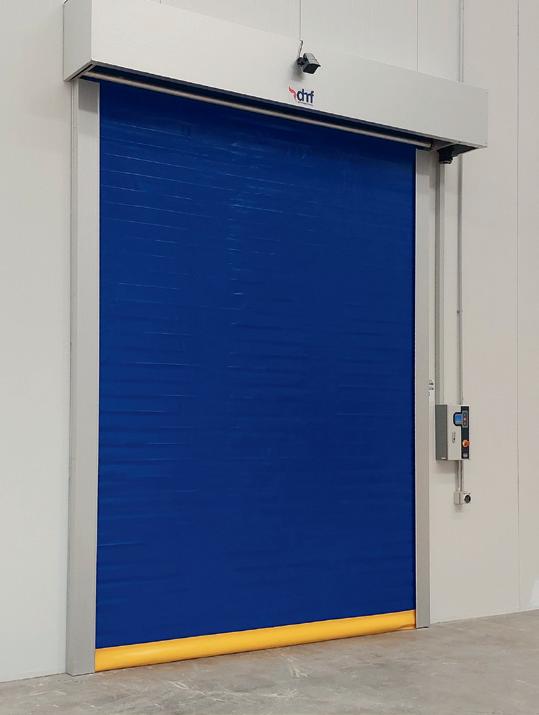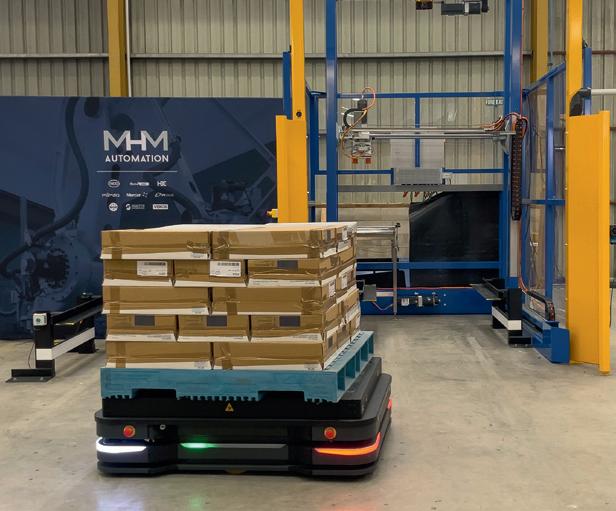
7 minute read
Optimising food manufacturing through artificial intelligence
Jarrod Kinchington, Infor ANZ Vice-President and Managing Director
The value of the market for artificial intelligence (AI) in the food and beverage sector is expected to exceed
AU$45 billion by 2026, with Asia–Pacific slated as the fastest growing region.
Already in use by pioneering businesses across the industry, it’s clear that AI is making its presence felt in more ways than one, impacting all aspects of the food supply chain, driving smarter, faster decisions and underpinning that all-important competitive advantage.
Whilst many in the industry have heard of AI, there is still widespread uncertainty as to how AI technologies can be applied and just what benefits can be reaped. Put simply, AI has the potential to optimise all areas of food manufacturing, facilitating smart, industry-specific applications to improve every aspect of the supply chain, from farm to fork, building agile supply chains and driving revenue growth.
Many regard AI as the machinery and technologies used to carry out complex tasks that previously required human thought to complete, but it goes even further than that, enabling new approaches to data analysis that simply are not possible to do manually. This is where AI comes into its own, with the ability to consider an inordinate number of data values, parameters, what-if scenarios and other contributing factors to produce accurate and timely recommendations for almost every aspect of the food supply chain. Ultimately, this provides a competitive advantage that would be impossible to replicate without the application of AI technologies.
AI in the food industry comprises a number of technologies, from robotics to machine learning, so where are we seeing AI in action across the industry and what impact is it having?
Precision farming
AI technologies are being used to bring new depths of precision to farming. So, this might be an analysis of past harvests in terms of both quantity and quality, in combination with weather forecasts to inform which fields need watering and when, or when to use fertiliser perhaps. In the aquaculture sector, there is a business that is using AI technology to ensure accurate doses of feed are administered in shrimp farming, avoiding over- and under-feeding. This serves to lower the feed conversion ratio and shortens the shrimp production cycle, doubling production without huge intensification.
Pricing strategy
Again, taking into account numerous factors, the application of AI technologies can inform a more effective pricing strategy. AI applications can quickly and effectively analyse all contributing variables, such as seasonality, competitor pricing, promotions, customer demand, etc, building up a clear picture of pricing history and trends, to inform recommendations regarding which products should be sold at which price to maximise revenues. There is already a leading European bakery ingredients business doing just this, implementing the right technology to achieve optimal pricing recommendations for its wide range of products.
Mitigate against unpredictability
Over the past two years in particular, the unpredictability of food supply chains has had a massive impact on food and beverage manufacturing. This is another area where AI can hold the key to unlocking new, better ways of working. For example, the right AI tools can predict sea vessel arrival times, helping manufacturers to more accurately forecast when their raw ingredients will be arriving. It is the level of detail that AI brings that makes all the difference. Not only can manufacturers secure a more accurate picture of when ingredients will arrive, but the technology can also factor in considerations such as how long deliveries will take to unload at the factory, instilling an even greater level of accuracy when it comes to scheduling production to optimise operations and maximise productivity.
Maximise yield
Many regard AI as the machinery and technologies used to carry out complex tasks that previously required human thought to complete, but it goes even further than that, enabling new approaches to data analysis that simply are not possible to do manually.
This granularity of information is what makes AI the cornerstone of more accurate, agile, predictable supply chains, helping businesses to plan for all eventualities and delivering the actionable insight needed to stay one step ahead of the competition.
Sustainability
The issue of sustainability is another area where AI is having a positive impact on food and beverage manufacturing. Businesses are able to use the insight generated by AI applications to minimise energy and water usage, ensuring the most energyefficient production, alongside waste reduction at all potential touch points in the manufacturing process. In a similar vein, machine learning-based specification matching and stock allocation enables manufacturers to ask if they can optimise the use of existing stock and still meet customer specifications.
As well, innovative businesses are taking quality information, in combination with ingredient shelf-life data, using AI to determine dynamic best before dates. AI answers the question of ‘can we extend the shelf life safely considering the quality at hand?’, which ultimately prolongs the sellable life of a product, reducing waste and increasing revenue. At the same time, AI technologies can facilitate smart shelves in supermarkets, where prices are adjusted based on remaining shelf life and point of sales history, reducing waste and increasing profitability further still.
The ability to maximise yield is yet another area where AI can make a world of difference. Internet of Things (IoT) devices in combination with machine learning are optimising machine settings to maximise yield. For example, manufacturers can ask how to maximise yield considering the quality of ingredients and the process conditions. Taking into account an almost inordinate number of process parameters, it is possible for manufacturers to use AI to maximise the output of processes at every step of the way.
AI is all about connecting the dots, making the most of the huge amounts of data generated by the food and beverage sector, and using AI technologies to analyse this data and gain a better understanding of the many and complex variables at play within the industry. As more businesses invest in AI technologies, suppliers can create more out-of-the box AI solutions. The learnings and experiences of food and beverage manufacturers inform AI templates that can then be applied to similar businesses, delivering the insight needed to maximise efficiencies and boost revenue.
To work, AI needs data. As long as there is data, it is possible to use AI technologies to recognise data trends and patterns, applying this learning and insight back to the business. It is this application of insight that is helping to create better, faster, more profitable operations at every stage of the supply chain, building a responsive and resilient food and beverage industry right across the world.
Jarrod Kinchington, Infor ANZ vice-president and managing director
Bulk material tipper
A new High-Volume OpenChute Tipper from Flexicon allows discharging of nondusty, free-flowing and/or agglomerated bulk materials from multiple drums or boxes simultaneously, as well as from Gaylords, totes or bins individually.

The bed of the unit’s hydraulically tipped housing can accommodate containers from 940 to 1115 mm in height, having an individual or combined footprint of up to 1825 x 2435 mm. Typical applications for multiple containers include simultaneous dumping of four 210 L drums, or four boxes, each having a footprint of 915 to 1220 mm.
Pallets weighing up to 2265 kg are forklift-loaded into the three-sided unit and secured, after which a grate is lowered onto the container(s) to prevent shifting. The lifting assembly is raised to a height of 1955 mm and tipped hydraulically, causing material to slide through a smooth, three-sided chute into receiving vessels.
Twin hydraulic cylinders pivot the platform-chute assembly to discharge angles of 45 or 60° beyond horizontal, including a motion-dampening feature at the termination of container rotation.
Impact-resistant side panels and custom guard panels with a light curtain help ensure safe operation.
The tipper is available in heavy-duty, all-stainless construction to sanitary standards or in carbon steel with durable industrial coatings and stainless steel material contact surfaces.
It is also available with optional receiving hoppers configured with Flexicon mechanical or pneumatic conveyors to transport discharged material to any plant location.
Flexicon Corporation (Aust) Pty Ltd www.flexicon.com.au
High-speed insulated door
High-trafficked doorways to food processing areas, coolrooms and freezers require a specialised door that will not only operate quickly and efficiently, but provide a high level of insulation. Sydney-based company DMF International has supplied rapid roll doors with flexible PVC type panels for over 30 years and now has a more efficient solution for these applications — the RL3000-Coldsaver high-speed insulated door.
The flexible high-speed door can withstand the harsh conditions of bulk commercial coolrooms and freezers, and the door blade is constructed using a 15 mm-thick door panel using polyskin 900 gsm outer layer and pocketing high-density insulated cores.
Based on a similar design to its Series RL3000 door, the Coldsaver door can provide a greater level of insulation to temperature and noise. It is suitable for opening sizes up to about 20 m2 and the doors are custom made to size and specification at its Sydney factory.

With operating speeds of over 1 m/s, and multiple safety sensors that prevent the door closing onto an object, the door is designed for hundreds of cycles a day.
DMF www.dmf.com.au
Automated technologies for palletising
MHM Automation has released the MHM Automated Mobile Robots (AMRs) and the H&C Gantry Palletiser and De-Palletiser.

The AMR is an automated vehicle which moves product on pallets or in crates, without the need for conveyors. Integrated navigation and vision technology enables the AMR to navigate and move safely around people and objects, making it suitable for congested production environments where automation would previously not have been possible. AMRs’ ability to work together as a fleet mean they are a scalable solution that can be used for operations large and small.
The H&C Gantry Palletiser and De-Palletiser (SimPal50) is capable of palletising or de-palletising up to eight boxes or bags per minute, an alternative to a robotic palletiser. The SimPal50 features MHM’s proprietary vision system, which enables it to identify and de-palletise boxes in a randomly stacked pattern. It reduces labour, allowing staff to be redeployed to higher value work and helps reduce the risk of injury through manual handling.
MHM Automation mhmautomation.com
Tim Symons









